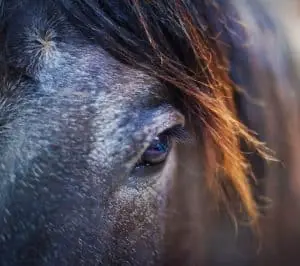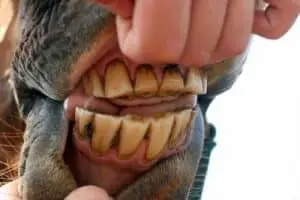At some point in most horse owners’ lives they’ll need to start thinking about the best way of looking after and caring for an older horse and if you’ve never done it before it can be quite daunting but it doesn’t need to be. With careful planning and a good understanding of what’s normal for your horse, there’s no reason why caring for an older horse needs to be any different from that of caring for a younger or middle-aged horse.
Should I stop riding an older horse?
There are no hard and fast rules about when, or if, you should stop riding a horse but when asked most people will generally say between the ages of 20 and 25, although this isn’t always the case for every horse. After all, horses are no different from us, we all age and start to slow down at different rates, while some people will still work well into their 90s other people will have to take early retirement decades before they reach the retirement age.
Before deciding to completely retire your horse it’s also important to consider whether doing so really is in his best interest, after all, if he’s always been very active and spent most of his days working is he really going to appreciate (or benefit from) being completely rested? Then there’s the argument that a little bit of exercise may actually help by keeping the muscles and joints flexible. While things like jumping and running the barrels may well be out of the question, that doesn’t mean to say a gentle ride a few times a week is a bad idea.
I know it seems like I’ve tried to avoid answering the question but, to be honest, there is no right or wrong response to this and the answer should actually as individual as the horse. If your horse is frail and is suffering from back and joint pain then, of course, riding him is a bad idea but if your horse was regularly used for competition then taking him for a light ride a couple of times a week will be advantageous.
If you don’t want to continue riding your horse but do want to exercise him then don’t worry, you can lunge him or put a halter on and take him for a walk. I know that might sound like a strange thing to say but there’s a lot more sense to it than you might think, he’ll enjoy the smells, get some gentle exercise, and best of all the two of you’ll be able to spend some quality time together.
What are the signs my horse is getting old?
Even though we all know it’s inevitable but age is something that always seems to creep up on us and the same can be said for our horses too, we spend so much time with them that we don’t always notice the things that change slowly over time. While not every horse will display the same signs of aging the most common things to look out for are:
- Gray hairs – As horses age, the pigment cells in their hair follicles start to die which results in that strand of hair having no color. Normally starting around their eyes and muzzle, this is far more apparent in horses with darker coats.
- Less pliable skin – It’s a common misconception that older skin is less elastic due to dehydration but in fact, it’s the body slowing down its production of collagen and elastin. Both of those, combined with hyaluronic acid, help to give the skin its ’stretchiness’ and as the body ages, they’re not produced to the same level.
- Decreased muscle strength – Muscles get weaker and smaller with age so as a horse gets older you’ll notice that he doesn’t have the strength that he once had and will get tired more quickly than he used to.
- Stiff joints – Over time the ligaments and tendons in-between a horse’s joints start to stiffen up and become more sinewy, this means that they’re not as flexible as they used to be while at the same time the cartilage can Strat to wear away in horses that have arthritis. These two factors can make it painful for the horse to move his joints.
- More tired after exercise – As a horse loses muscle strength and his joints become stiffer exercise can become much harder which is why older horses can become far more tired after exercise. The harder the exercise the more evident the horse’s tiredness will be.
- Loss of weight – While the loss of weight is rarely a sign of old age it is often a byproduct of something else such as a less effective digestive system or tooth wear.
- Generally slowing down – Most of us have seen elderly relatives slow down as they get older and horses are no different. As they begin to age so does everything else and they no longer have the energy that they had ten years ago.
- Less resistance to infections – While it’s not true for every horse, as a lot of horses age their immune system gets weaker which means that they are more at risk of infection.
Health care for the older horse
Every horse owner knows it’s crucially important to check things like their teeth and hooves regularly but as the horse gets older this becomes even more important. To help keep your horse healthy as he gets older it’s important to closely monitor things such as his teeth, hooves, and his digestive system as well as keeping an eye out for any problems he has with parasites.
Teeth
Horses have hypsodont teeth which means that they continue to grow and are worn down by grazing. By the time a horse reaches his 20s though his teeth have stopped growing, this means that they can become more uneven and could even fall out. This can result in your horse finding it difficult to chew his food properly which can results in him either not eating all of his food or taking a long time to do so and therefore not getting all of the nutrients he needs from him. This is why it’s important to regularly check his teeth, when doing so you need to look out for abnormalities such as ‘wave’ mouth, overgrowth of the teeth as well as the loss of a tooth.
- Wave mouth – This is a condition where the teeth wear unevenly, causing a wave-like pattern. This can result in the horse’s teeth wearing out more quickly as well as food pocketing where the horse has ‘pockets’ of food left in his mouth after eating which can lead to bacterial infections. Wave mouth can also prevent the horse from being unable to chew his food properly which, in turn, often results in the horse not getting the nutrients he needs from his food.
- Overgrowth – Sometimes known as parrot mouth, this is where a tooth is overlapping its opposite tooth, not always but very often caused by the loss of a tooth. If it’s not treated this can cause a lot of pain to the inside of the horse’s mouth making it difficult for them to eat. In extreme cases, the horse simply won’t eat at all.
Hooves
Just because your horse’s workload is lighter than it was when he was younger it doesn’t mean that you don’t need to have a farrier check them at least once a year, if not twice. One of the reasons for this is older horses are more prone to suffering bouts of laminitis, especially if they also have Cushing’s Disease which is also more common in older horses.
It’s important that you regularly check your horse’s hooves as well as monitor how he’s moving. Doing this won’t prevent laminitis but it will make treating it much easier as well as reducing the impact it may have on your horse.
Digestive system
Older horses can have problems with their digestive system for any number of reasons but ultimately the result is still weight loss and poor body condition. As well as regularly checking your horse’s teeth and having an effective worm management program you should also ensure your horse has plenty of good quality pasture, as well as fresh, clean food and water.
You might want to also think about changing your horse’s feed to one more suitable for older horses. Most companies have feeds that have been developed especially for older horses. These are easier for them to chew and digest.
Parasites
As horses age their immune systems weaken and aren’t able to fight off infection and disease as well as it could which is why it’s important to check your horse for parasite problems regularly. While it’s still important to keep as many flies at bay as you can imagine it’s more the parasites horses get from worms that are the problem. To check your horse for signs of a problem you need to look for things like:
- Loss of condition of his coat. Horses will lose condition as they age but has it suddenly changed, is it more course than normal, does it look dull, is he molting more than normal?
- Loss of weight and body condition. I don’t mean the normal weight loss a horse may experience as he gets older but any sudden and unexplained loss of weight and body condition could be an indication of a problem with parasites.
- Inconsistent feces. If your horse’s bowel movements have changed and are changing between being soft and diarrhea it could be his body trying to deal with parasites in his colon.
- Tail rubbing – Some worms, such as pinworm, can cause a horse to rub the top of their tail to such an extent its red raw. This is due to the parasites causing itching around the horse’s anus.
- Colic – While all horses can suffer from colic at any stage of their life recent studies have shown that as a horse gets older he is far more likely to suffer from colic, possibly in part due to digestive issues leading to impaction.
Why do older horses lose body condition?
For many years there was a widely held belief that as a horse got older it was inevitable that he would lose weight and body condition but it turns out that this isn’t quite a straightforward as that. Yes, as a horse ages he is more likely to lose condition but recent studies have shown that it’s not the horse’s age that causes this, it is, in fact, a result of other age-related problems rather than the age itself. For example, if a horse is having problems with his teeth then it stands to reason that he is more likely to not be digesting his food as efficiently. This will, if not addressed, over time, result in a loss of weight and most likely body condition too.
It’s for this reason that its even more important to regularly check your horse and keep a closer eye on him as he gets older. After all, it’s far easier, and cheaper, in the long run, to get a horse’s teeth sorted than it is to buy extra feed, hay and even supplements.
Regardless of a horse’s age, he should score between 3 and 5 and no lower than 2 on the Henneke Body Condition Scoring System (Devised by Dr. Henneke at Texas University, the scoring system is now used worldwide to measure a horse’s condition. It measures certain areas along the horse’s body to get an overall score that gives the horse’s condition.) (see the chart below). The reason for this is that, especially in older horses, a lower score will result in a reduced immune system as well as make it harder for the horse to deal with extreme temperatures (both hot and cold). While a higher score is far less likely in older horses, it can increase a horse’s chances of getting laminitis.
1 – Poor
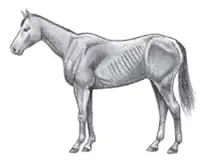
- Neck – Noticeable thickening of the neck, fat deposited along inner buttocks.
- Withers – Area along withers filled with fat.
- Loin – Positive crease down back.
- Tailhead – Tailhead fat very soft.
- Ribs – Difficult to feel ribs.
- Shoulder – Area behind shoulder filled in flush with the body.
2 – Very Thin
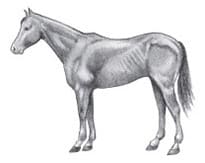
- Neck – Faintly discernible, animal emaciated.
- Withers – Faintly discernible.
- Loin – Slight fat covering over base of spinous processes. Transverse processes of lumbar vertebrae feel rounded. Spinous processes are prominent.
- Tailhead – Tailhead prominent.
- Ribs – Slight fat cover over ribs. Ribs easily discernible.
- Shoulder – Shoulder accentuated.
3 – Thin
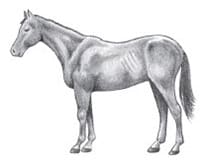
- Neck – Neck accentuated.
- Withers – Withers accentuated.
- Loin – Fat buildup halfway on spinous processes but easily discernable. Transverse processes cannot be felt.
- Tailhead – Tailhead prominent but individual vertebrae cannot be visually identified. Hook bones appear rounded but are still easily discernable. Pin bones not distinguishable.
- Ribs – Slight fat cover over ribs. Ribs easily discernible.
- Shoulder – Shoulder accentuated.
4 – Moderately Thin
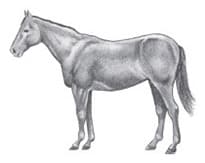
- Neck – Neck not obviously thin.
- Withers – Withers not obviously thin.
- Loin – Negative crease along the back.
- Tailhead – Prominence depends on conformation; fat can be felt. Hook bones not discernable.
- Ribs – Faint outline discernable.
- Shoulder – Shoulder not obviously thin.
5 – Moderate
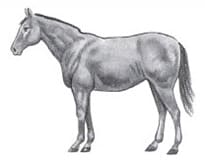
- Neck – Neck blends smoothly into the body.
- Withers – Withers rounded over spinous processes.
- Loin – Back level.
- Tailhead – Fat around tailhead beginning to feel spongy.
- Ribs – Ribs cannot be visually distinguished but can be easily felt.
- Shoulder – Shoulder blends smoothly into the body.
6 – Moderately Fleshy
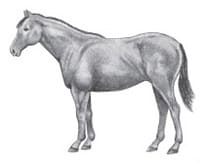
- Neck – Fat beginning to be deposited.
- Withers – Fat beginning to be deposited.
- Loin – May have a slight positive crease down back.
- Tailhead – Fat around tailhead feels soft.
- Ribs – Fat around tailhead feels soft.
- Shoulder – Fat beginning to be deposited.
7 – Fleshy
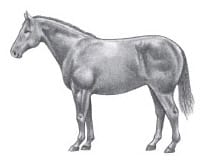
- Neck – Fat deposited along the neck.
- Withers – Fat deposited along the withers.
- Loin – May have a positive crease down back.
- Tailhead – Fat around tailhead is soft.
- Ribs – Individual ribs can be felt, but noticeable filling between ribs with fat.
- Shoulder – Fat deposited behind the shoulder.
8 – Fat
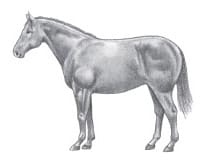
- Neck – Noticeable thickening of the neck, fat deposited along inner buttocks.
- Withers – Area along withers filled with fat.
- Loin – Positive crease down back.
- Tailhead – Tailhead fat very soft.
- Ribs – Difficult to feel ribs.
- Shoulder – Area behind shoulder filled in flush with the body.
9 – Extremely Fat
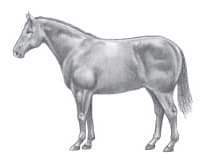
- Neck – Bulging fat. Fat along inner buttocks may rub together. Flank filled in flush.
- Withers – Bulging fat.
- Loin – Obvious positive crease down back.
- Tailhead – Building fat around tailhead.
- Ribs – Patchy fat appearing over ribs.
- Shoulder – Bulging fat.
From Henneke et al. Equine Vet J. (1983) 15 (4), 371-2.
What should you feed older horses to help them gain weight?
If your horse has lost weight and there’s no underlying reason for it except for his age then there are a number of things you can do to help increase his weight. To start with make sure that your horse has a regular supply of good quality hay as well as plenty of fresh water. The hay will help to increase bulk while the water will help with his digestion.
In terms of food, the general rule is that a horse should eat 2.5% of his ideal weight (you can see what his ideal weight should be here) spaced out over 3 to 4 meals a day. You can also add supplements to his feed if necessary to increase his calorie intake, although these should be introduced gradually over time – typically over a 2 to 3 week period.
Vegetable oil is often added to the feed of older horses for a number of reasons. It can be used to increase the condition of a horse’s coat but is also used to help ease joint pain and arthritis. Another advantage of vegetable oil is that its broken down by the body slowly and gives extra fuel to the muscles.
Common issues associated with old age in horse
As you would expect, when a horse gets older, his chances of suffering from a range of ailments increases, some of them are more common than others but the most common conditions are:
- Arthritis
- Respiratory problems
- Joint pain
- Weight loss
- Dental issues
- Colic
- Cushing’s disease
- Cataract
- Laminitis
Further reading
- Do horses need supplements?
- Keeping a hard keeper on a budget
- How to prevent laminitis
- How to treat colic
- Guide to hoof care
- Do horses have fleas?
- Do horses get depressed?
- Healthy treats for horses
- 20 things to never feed a horse
I hope you found this article helpful. If you did I’d be grateful if you could share it please as it would really help me.
Recommended products
Over the years I have tried hundreds of different horsey products, from various blankets and halters to different treats. Some I’ve loved, others I’ve hated but I thought I’d share with you my top all-time favorite products, the ones I never leave the yard without. I’ve included links to the products (which are in no particular order) that I really think are great.
- Horse Knots by Reference Ready – If you’re like me and enjoy pocket reference guides then you’ll love this knot tying guide. These handy cards can easily fit in your pocket or attach to the saddle for quick reference. They’re waterproof, durable and are color coded to make them easy to follow.
- Mane ’n Tail Detangler – Even if you never show your horse you’ll need to detangle his tail from time to time (and possibly his mane too) which is always a challenging chore! I’ve found that if I run a little bit of detangler through my horse’s tails every few days it stops them from getting matted up and makes combing them easy, even if they’re coated in mud. I don’t know if I should admit to this or not but it also works wonders on my hair.
- TAKEKIT Pro clippers – Over the years I’ve tried a lot of different clippers and while some were obviously better than others I found these to be by far the best. They are heavier than a lot of other clippers but for me, that’s a good thing, it makes them feel more sturdy and hardwearing. On top of that they have a range of speeds so are just as good for clipping your horse’s back as they are his face. I also like the fact that they come in a handy carry case but that’s not for everybody. The company that makes them is super good and incredibly helpful too, a real bonus these days. The only thing I wasn’t keen on was the fact that it doesn’t come with any oil, but that’s not a major problem as it’s not difficult to buy lubricant.
- Shire’s ball feeder – There are so many boredom buster toys out there but I like to use these every day, regardless of whether or not my horses are bored. I find that it helps to encourage my horses to problem solve by rewarding them with treats (or pieces of fruit) but it also mimics their natural grazing behavior which helps to keep them calm and de-stressed.
- Horse safe mirror – This is a strange one that many people are surprised about but I like to put horse safe mirrors in the trailers as well as in the quarantine stalls. It helps to prevent the feeling of isolation by giving the impression of other horses being around. Being herd animals horses can get extremely stressed when they feel that they’re on their own but with these stick-on mirrors, they believe that at least one other horse is with them.
- Rectal thermometer – I know this isn’t glamourous at all but it’s vital for your horse’s well-being to be able to check their temperature and a rectal thermometer is the easiest way of doing this which is why I’ve added it to the list.
Shopping lists
I’ve also put together a few shopping lists of essential items that I’ve found helpful over the years. I’ve broken the lists down into different categories rather than put everything in one massive list 😉

